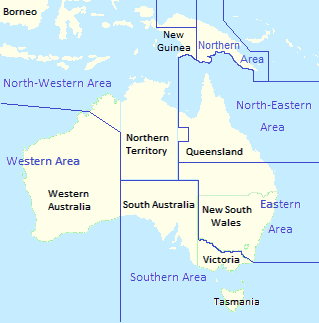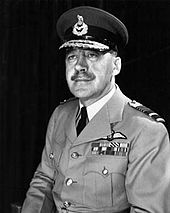RAAF area commands

Area commands were the major operational and administrative formations of the
The area commands and their responsibilities evolved over time according to changing circumstances. The RAAF established four commands to begin with in 1940–41:
By the early 1950s, most operational units were based within Eastern Area Command, most Air Force training was controlled by Southern Area Command, and maintenance was the responsibility of
History
Origin and purpose

On the eve of World War II, the
In January 1940, the
Evolution and control
The RAAF planned four area commands initially: Southern Area, covering all units in Victoria, Tasmania, South Australia and the southern Riverina district of New South Wales; Central Area, covering units in New South Wales except southern Riverina and the north of the state; Western Area, covering units in Western Australia; and Northern Area, covering units in northern New South Wales, Queensland, Northern Territory and Papua. The first two commands established, in March 1940, were Southern Area, which essentially took over the role and headquarters of No. 1 Group in Melbourne, and Central Area, which evolved from No. 2 Group in Sydney. Western and Northern Areas eventually followed in January and May 1941, respectively; pending their formation, units in Queensland were temporarily controlled by Central Area Command, and those in Western Australia, Northern Territory and Papua came under the direct control of RAAF Headquarters.[7][10]
By mid-1941, RAAF Headquarters had determined to form training units in the southern and eastern states into semi-geographical, semi-functional groups separate to the area commands. This led to the establishment in August of No. 1 (Training) Group in Melbourne, covering Victoria, Tasmania and South Australia, and No. 2 (Training) Group in Sydney, covering New South Wales and Queensland.[11][12] Central Area was then disbanded and its responsibilities "divided as convenient", according to the official history of the war, between Southern Area, Northern Area, and No. 2 (Training) Group.[11] Western Area retained responsibility for training, as well as operations and maintenance, within its boundaries.[12]
With the outbreak of the
Until 1942, RAAF Headquarters exercised complete operational and administrative control over the area commands. In April that year, Allied Air Forces (AAF) Headquarters was established under General
To help overcome the static nature of the area command system, in September 1942 the RAAF created a large mobile formation known as
Near the end of the war,
Post-war organisation and supersession

Following the end of the Pacific War in August 1945, SWPA was dissolved and the Air Board again assumed full control of all its operational formations.[29] Nos. 1 and 2 (Training) Groups, and No. 5 (Maintenance) Group, were disbanded between January and March 1946.[30] Northern Command, having been re-designated Northern Area in December 1945, was disbanded in February 1947. The other area commands continued to function with essentially the same boundaries as during the war, except that North-Western Area no longer covered the Dutch East Indies.[1][30]
In the aftermath of the war, a geographically based command-and-control system was considered outmoded, and calls came to replace it with a system based on function.[31] Bostock, who found the area boundaries "arbitrary", proposed a functional structure consisting of operational, maintenance, and training commands.[32] With hindsight, the area commands were judged adequate for the organisation of the Air Force in the early years of World War II, but not for the rapid response times and concentration of force necessary to properly prepare for attacks on Australia following the start of the Pacific War, nor for conducting offensive operations from 1943 onwards.[33] Air Marshal Jones, who had retained his position as Chief of the Air Staff (CAS) following the war, resisted pressure to replace the area structure. He was persuaded by his staff to set up a conference to discuss the possibility of change, but participation by the CAS, who had been satisfied with the wartime system, and the area commanders themselves, whose positions were on the line, was half-hearted at best.[31] Jones did suggest reducing the number of area commands to three (Northern Area to cover Queensland and the Northern Territory, Eastern Area to cover New South Wales, and Southern Area to encompass Western Australia, South Australia, Victoria and Tasmania) as part of a much larger proposal to restructure the post-war RAAF, but this never eventuated.[34]
The Federal government retired Jones in February 1952 and replaced him with an RAF officer, Air Marshal

Home Command was formed from the existing Eastern Area Command, which was considered a de facto operational organisation owing to the preponderance of such forces within its boundaries. Training Command was formed from Southern Area Command, as it was already the hub of training services, controlling those in New South Wales and Queensland as well as Victoria and South Australia.[38] Maintenance Command was formed from the extant Maintenance Group—as No. 4 (Maintenance) Group had been known since July 1947—headquartered in Melbourne.[37][39] The transition to a functional system was completed in February 1954, when the three new commands assumed control of all operations, training and maintenance from Western, North-Western, and North-Eastern Area Commands.[37] The headquarters of these three area commands remained in existence but only, according to the Melbourne Argus, as "remote control points" for Home Command.[40] North-Western Area Command was disbanded in June 1955, Western Area Command in November 1956, and North-Eastern Area Command in December 1956.[30]
Aftermath
The functional commands established in 1953–54 were revised in 1959. Home Command was renamed Operational Command, and Training and Maintenance Commands merged to become
Summary of area commands formed
The RAAF raised eight area commands over the course of World War II, and five of them continued to operate into the 1950s:
| Command | Formation | Supersession/disbandment | Re-formed as |
|---|---|---|---|
| Southern Area Command | 1940 |
1953 |
Training Command
|
| Central Area Command | 1940 |
1941 |
|
| Western Area Command | 1941 |
1954/1956 |
|
| Northern Area Command | 1941 |
1942 |
North-Eastern Area Command North-Western Area Command |
North-Eastern Area Command |
1942 |
1954/1956 |
|
North-Western Area Command |
1942 |
1954/1955 |
|
| Eastern Area Command | 1942 |
1953 |
Home Command
|
| Northern Command | 1944 |
1947 |
Northern Area (in 1945) |
RAAF organisation chart

Notes
- ^ a b c d Stephens, The Royal Australian Air Force, pp. 111–112
- ^ a b Gillison, Royal Australian Air Force, pp. 66–67 Archived 8 August 2017 at the Wayback Machine
- ^ a b "Organising for War: The RAAF Air Campaigns in the Pacific" (PDF). Pathfinder. No. 121. Canberra: Air Power Development Centre. October 2009. Retrieved 14 August 2017.
- ^ Gillison, Royal Australian Air Force, pp. 90–91 Archived 17 August 2017 at the Wayback Machine
- ^ Ashworth, How Not to Run an Air Force, p. 24
- ^ Ashworth, How Not to Run an Air Force, p. 26
- ^ a b c Gillison, Royal Australian Air Force, pp. 91–92 Archived 17 August 2017 at the Wayback Machine
- ^ Ashworth, How Not to Run an Air Force, pp. xx, 30
- ^ Ashworth, How Not to Run an Air Force, p. 1
- ^ Ashworth, How Not to Run an Air Force, pp. 27–29
- ^ a b Gillison, Royal Australian Air Force, p. 112 Archived 17 August 2017 at the Wayback Machine
- ^ a b Ashworth, How Not to Run an Air Force, pp. xx, 38
- ^ Gillison, Royal Australian Air Force, p. 311 [permanent dead link]
- ^ a b Ashworth, How Not to Run an Air Force, pp. xxi, 134–135
- ^ Gillison, Royal Australian Air Force, p. 478 Archived 17 August 2017 at the Wayback Machine
- ^ a b Stephens, The Royal Australian Air Force, pp. 144–145
- ^ Gillison, Royal Australian Air Force, p. 588 Archived 17 August 2017 at the Wayback Machine
- ^ Gillison, Royal Australian Air Force, p. 473 Archived 17 August 2017 at the Wayback Machine
- ^ Odgers, Air War Against Japan, pp. 15–16 Archived 17 August 2017 at the Wayback Machine
- ^ Gillison, Royal Australian Air Force, pp. 585–588 Archived 17 August 2017 at the Wayback Machine
- ^ Odgers, Air War Against Japan, pp. 4–6 Archived 17 August 2017 at the Wayback Machine
- ^ Gillison, Royal Australian Air Force, pp. 476–477 Archived 17 August 2017 at the Wayback Machine
- ^ Stephens, The Royal Australian Air Force, pp. 144, 168
- ^ Odgers, Air War Against Japan, pp. 182–183, 198–200 Archived 22 August 2017 at the Wayback Machine
- ^ Ashworth, How Not to Run an Air Force, pp. 227–229
- ^ Ashworth, How Not to Run an Air Force, pp. 214–217, 227–228
- ^ Ashworth, How Not to Run an Air Force, p. xxiii
- ^ "RAAF organisation". National Archives of Australia. 1943–45. pp. 18–23. Retrieved 14 August 2017.
- ^ Ashworth, How Not to Run an Air Force, p. 262
- ^ a b c "Order of Battle – Air Force – Headquarters". Department of Veterans' Affairs. Retrieved 14 August 2017.
- ^ a b Helson, Ten Years at the Top, pp. 252–254
- ^ Stephens, Going Solo, p. 66
- ^ Ashworth, How Not to Run an Air Force, p. 277
- ^ Helson, Ten Years at the Top, p. 257
- ^ Helson, Ten Years at the Top, pp. 291–296
- ^ a b c "Sir Donald Hardman's Reorganisation of the RAAF" (PDF). Pathfinder. No. 106. Canberra: Air Power Development Centre. March 2009. Retrieved 14 August 2017.
- ^ a b c d Stephens, Going Solo, pp. 73–76
- ^ Stephens, Going Solo, pp. 73–76, 462–463
- ^ No. 4 Maintenance Group (1947). Operations Record Book. Unit History Sheets (Form A50). Canberra: Directorate of History – Air Force. p. 103.
{{cite book}}: CS1 maint: numeric names: authors list (link) - ^ "Battle 'nerve-centre' goes north RAAF fighting control shifted from here". The Argus. Melbourne: National Library of Australia. 21 May 1954. p. 5. Retrieved 14 August 2017.
- ^ Stephens, Going Solo, pp. 76–77
- ^ Dennis et al, The Oxford Companion to Australian Military History, pp. 150–151
- ^ Stephens, The Royal Australian Air Force, p. 307
- ^ "Program 6: Support Command" (PDF). Defence Annual Report 1997–98. Canberra: Department of Defence. 1998. p. 224. Retrieved 14 August 2017.
- ^ Horner, Making the Australian Defence Force, pp. 278–279
- ^ "Air Force Training Group". Royal Australian Air Force. Archived from the original on 8 August 2017. Retrieved 14 August 2017.
- ^ "Air Command". Royal Australian Air Force. Archived from the original on 20 July 2008. Retrieved 14 August 2017.
References
- Ashworth, Norman (2000). How Not to Run an Air Force! Volume One – Narrative (PDF). Canberra: RAAF Air Power Studies Centre. ISBN 978-0-642-26550-0.
- Dennis, Peter; Grey, Jeffrey; Morris, Ewan; Prior, Robin (2008) [1995]. The Oxford Companion to Australian Military History. South Melbourne: ISBN 978-0-19-551784-2.
- Gillison, Douglas (1962). Australia in the War of 1939–1945: Series Three (Air) Volume I – Royal Australian Air Force 1939–1942. Canberra: OCLC 2000369.
- Helson, Peter (2006). Ten Years at the Top (Ph. D thesis). Sydney: OCLC 225531223.
- ISBN 978-0-19-554117-5.
- OCLC 246580191.
- Stephens, Alan (1995). Going Solo: The Royal Australian Air Force 1946–1971 (PDF). Canberra: ISBN 978-0-644-42803-3.
- Stephens, Alan (2006) [2001]. The Royal Australian Air Force: A History. London: Oxford University Press. ISBN 978-0-19-555541-7.



